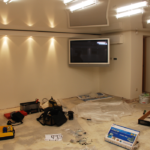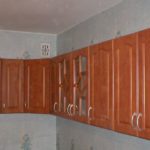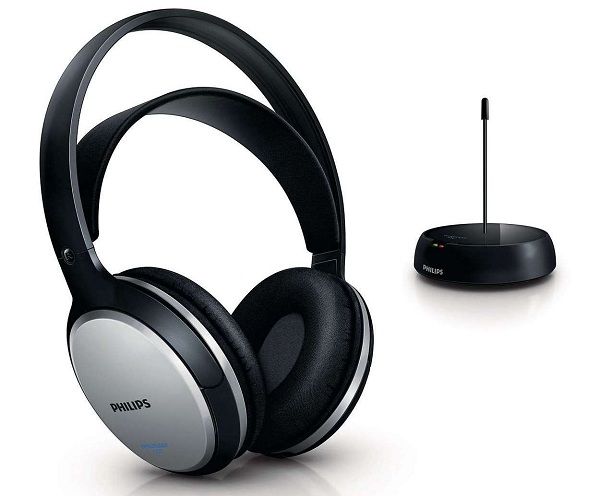How to hang a TV on the wall
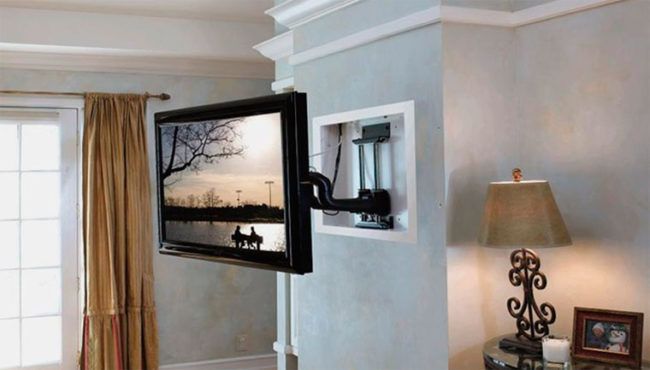 The TV is mounted on the wall using a wall bracket. This device can be purchased at a store or made independently. It’s not difficult to hang a wall-mounted TV yourself, without the help of an invited master, if you have a drill, hammer and screwdriver in the house.
The TV is mounted on the wall using a wall bracket. This device can be purchased at a store or made independently. It’s not difficult to hang a wall-mounted TV yourself, without the help of an invited master, if you have a drill, hammer and screwdriver in the house.
The content of the article
How to mount a TV on a wall
The installation process looks simple, the bracket can be secured to the surface with 4 bolts, then the TV is hung on it.
The wall-mounted television receiver is installed at a certain height. You can hang it at a standard height (from 0.7 to 1 m from the floor plane) or choose any convenient point. In homes where there are small children, such devices should hang at a height inaccessible to them.
In the kitchen, TVs are hung higher than in the bedroom or living room. Kitchen television receivers are located at a sufficient distance from water and fire.
Ideally, the television cord will reach the outlet without an extension cord. Extra wires strung around the room create inconvenience.
Important! You can drill into the wall only in areas where there are no hidden pipes or wiring. During finishing work, builders hide water pipes and electrical wires under decorative cladding.
A television is one of the household items that is part of a person’s comfort zone.Therefore, it is installed so that while watching programs, its owner feels as comfortable as possible.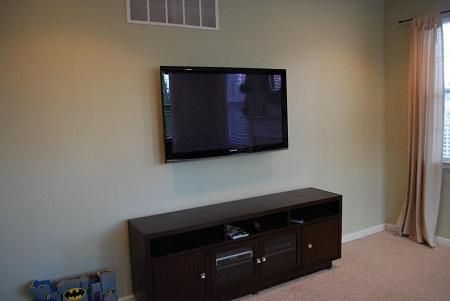
In brightly lit rooms, television equipment is found in a place where its screen is not illuminated by sunlight during the day. In the bedroom and living room, the television receiver is installed (fixed) opposite:
- sofa;
- beds;
- set of upholstered furniture.
The distance from the viewer to the screen should be 2 meters or more. It is convenient to watch programs when the image is at eye level.
What should the wall be like?
You can’t hang a household device on every wall. You cannot hang heavy objects on emergency walls that are collapsing, rotting, or crumbling.
Before taking on this work, you need to determine the quality of the surface. The wall can be built from:
- bricks;
- wood;
- expanded clay blocks;
- cellular concrete;
- finished frame panels;
- adobe;
- ceramic concrete;
- drywall.
The easiest way to install a household device is on a brick wall. It is drilled quite simply and the fasteners sit quite tightly inside the hole. It is more difficult to hang equipment on a thick layer of plaster or drywall. Fasteners do not hold well in brickwork if a dowel or nail gets caught between the bricks. It’s even worse if the bricks are held in place by a mortar that contains more sand than binder.
Attention! Residents of panel houses will need a hammer drill. Drilling a hole in concrete is more difficult than drilling a hole in brick.
It is believed that televisions cannot be hung on a plasterboard plane. In practice, drywall can withstand weights of up to 15 kg. Installation of the equipment is carried out using a butterfly dowel or a stud-screw.The safest thing to do is to use a magnet to find the profile guides on which the sheet of drywall is held, and attach the structure to them.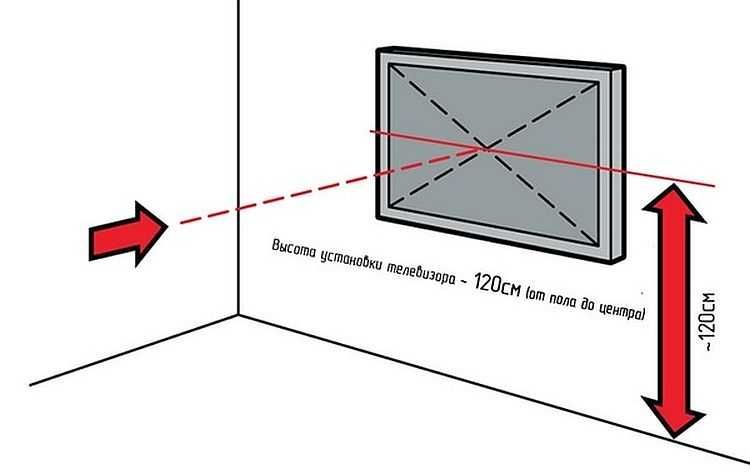
You shouldn’t even try to install heavy equipment on a lightweight plywood partition. A heavy object will break a hole with its weight and fall down. You can raise the TV to the desired height using a floor stand with adjustable vertical holders. The device is convenient due to its mobility; it can be moved at will to any place.
Due to the flowability of the material, adobe walls are not suitable for attaching heavy objects to their surface. Craftsmen manage to hang household equipment on adobe, working in stages:
- treat the selected surface area with deep penetration impregnation;
- drill holes;
- fill the holes with cement mortar;
- drill the cemented area;
- screw in a dowel with a self-tapping screw.
Such complex work does not always lead to the desired result; a piece of cement may not withstand the load and simply fall out of the wall. In such cases, when installation on walls is not possible, you can purchase a ceiling bracket and mount the TV receiver on it.
Installing a TV on a wall with a bracket
The easiest way is to purchase a special standard bracket. There may be several types of such products in stores, all of them differ in functionality and price. All brackets have mounting points. The distance between them corresponds to the standard.
Installing the TV is done as follows:
- Points for drilling holes are placed on the surface of the wall. Height is measured from the floor up. Using a level, a horizontal segment is drawn from the set point to the left and right.
- The lower mounting holes of the bracket are aligned so that the marked segment passes through them.
- Points for drilling holes are marked through the holes with a pencil.
- Using a special tool (a drill or hammer drill will do), holes are drilled at the designated points. The drill is selected slightly thinner than the diameter of the fastener.
- Using a screwdriver, screw the screws into the holes.
- The structure will hang more securely if you hammer dowels into the holes and then screw self-tapping screws into them. The drill must match the size of the dowel.
- The holes of the attached suspension and bracket are aligned, and the bolts are tightened. On the bracket, after the latter is securely mounted on the wall.
Wires strung throughout the house create inconvenience and give the interior an untidy appearance. At the end of the work, the television electrical cord and antenna wire are hidden in the cable channel.
Assembling the bracket correctly is not difficult. The main thing is to follow the instructions.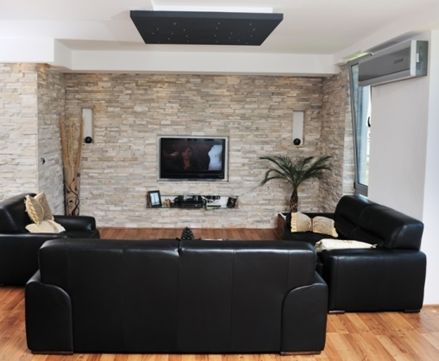
How to hang a TV on the wall without a bracket
Modern flat-screen TVs with large diagonals can be hung without using any devices. Manufacturers have provided special parts (grooves or ears) on the back panel of the device for this purpose.
The latest models of television receivers are no more difficult to hang on walls than mirrors and paintings. In this work, the main thing is to choose the appropriate fasteners.
The installation process is carried out in the following sequence:
- Down from the selected point, using a plumb line, measure the distance to the floor.
- The length of the segment from the bottom edge of the TV to the upper mounting points is added to the resulting indicator. For example, a television receiver should hang at a height of 1.2 m + 40 cm from the edge of the TV to the lugs on the back panel, we get 1.6 m.
- A height point is marked on the wall and a straight line is drawn through it using a level.
- Measure the distance between the centers of the holes in the grooves (ears) on the back wall of the panel.
- Left and right in a straight line are spaced at an equal distance from the center point by half the size. If there are 50 cm between the grooves, then put 25 cm from the center to the sides and put marks.
- At the marked points, drill holes with a drill or hammer drill.
- Dowels are driven into the holes with a hammer.
- Screw in self-tapping screws of the appropriate size.
Special holes are drilled on the hinges (ears) of the back panel; they widen downwards and narrow upwards. Self-tapping screws are threaded through the loop holes in their lower part. Then, the unit sinks down a little under its own weight. The TV cannot slide off the fastener, since the head of the fastener is clamped in the narrow part of the hinge.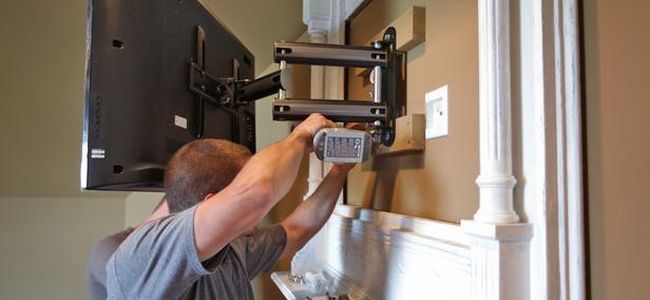
It is more convenient to hang the TV on a prepared place and take measurements with someone’s help. It is very difficult to hold a plumb line and measure the height at the same time alone.
A shelf made of hypocardboard or wood will help to hold the equipment on the wall. It is screwed so that the bottom edge of the equipment rests on it.
Instead of a bracket, you can use laminated chipboard and a strip of finishing material of suitable length and width. They do it like this:
- Laminated chipboard is attached to any fragile wall surface (adobe, plasterboard).
- The surface of the laminated chipboard is covered with a decorative strip (plastic, wallpaper).
- The bracket and TV are attached to the lined surface.
Large equipment with a lot of weight can be installed on two laminated chipboards. The decorative panel can additionally carry shelves.
The process of installing a TV on a wall surface involves marking the mounting points, selecting suitable fasteners, and drilling holes. Those who are not confident in their abilities can always use the services of specialists; they can install equipment on any wall, be it plasterboard or foam block.
Maximum TV weight
The permissible weight of the equipment depends on several factors:
- the material from which the wall is built;
- bracket type;
- quality of fasteners.
For plasterboard walls, the permissible upper limit for the weight of suspended equipment is 15 kg. Provided that it will be attached to the surface with butterfly dowels. If the device is hung on supporting rails using long rods - bolts, the load can be increased to 20 kg.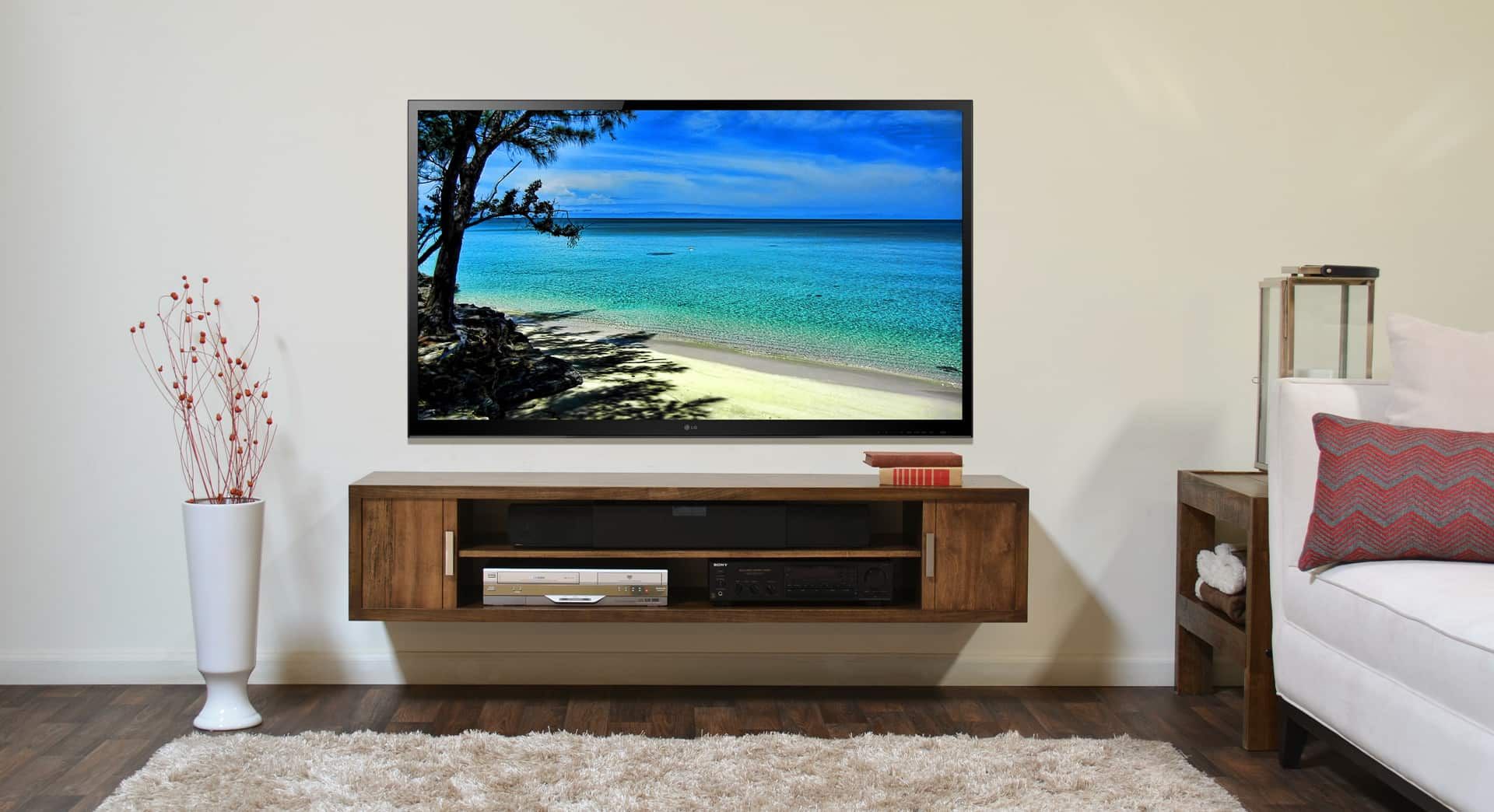
Advice! Manufacturers recommend that large TVs weighing over 25 kg be installed on the wall with an assistant.
All factory brackets have instructions that indicate the maximum permissible loads. Fixed wall products, made in the form of a cross, can withstand weight up to 25 kg.
Fixed brackets with a back panel can support a weight of up to 35 kg, provided that the wall on which it is installed is built of ceramic concrete blocks or bricks.


